How to avoid getting scammed by fake "Your System Is Infected With 3 Viruses" sites
Phishing/ScamAlso Known As: "Your System Is Infected With 3 Viruses" pop-up
Get free scan and check if your device is infected.
Remove it nowTo use full-featured product, you have to purchase a license for Combo Cleaner. Seven days free trial available. Combo Cleaner is owned and operated by RCS LT, the parent company of PCRisk.com.
What kind of scam is "Your System Is Infected With 3 Viruses"?
Our researchers discovered the "Your System Is Infected With 3 Viruses" scam while investigating suspicious websites. This fake alert claims that the user's Android device is infected with three viruses. Typically, scams of this kind endorse software, which is often fraudulent or downright dangerous.
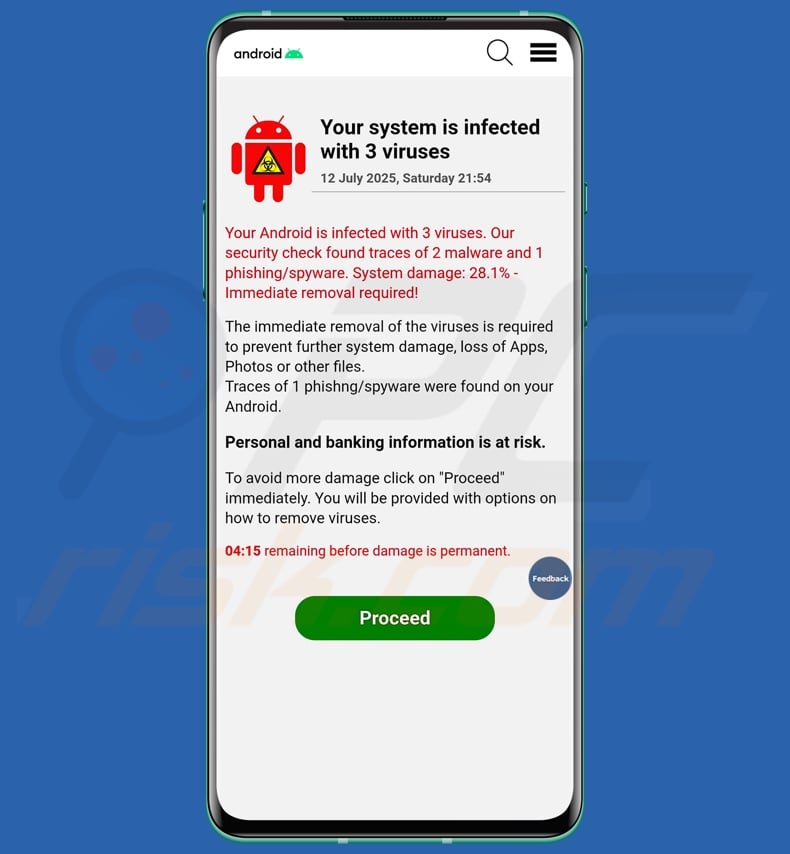
"Your System Is Infected With 3 Viruses" scam overview
This scam states that the visitor's Android operating system is infected with three viruses – two malware-type programs and one from the spyware category. The system has already suffered 28.1% damage, and the user risks further harm to the device, application loss, photo and other file corruption, and private/banking data exposure.
The page depicts a countdown timer, claiming that when the time runs out – the damage will become permanent. The user is instructed to click "Proceed" to remove the viruses.
It must be stressed that the information provided by this webpage is false, and the scam is not associated with any official service providers or other entities.
In most cases, scams that use infection-themed lures promote software. Commonly endorsed programs include fake anti-virus tools, PUAs (Potentially Unwanted Applications), adware, and browser hijackers. We have even found instances of such scams spreading trojans, ransomware, and other malware.
Virus-centered bait is also utilized by affiliate scams that abuse the affiliate programs of genuine products/services – the scammers' goal is to acquire illegitimate commissions. However, it is noteworthy that this scam could operate differently.
In summary, by trusting a website like "Your System Is Infected With 3 Viruses" – users can experience system infections, serious privacy issues, financial losses, and identity theft.
| Name | "Your System Is Infected With 3 Viruses" pop-up |
| Threat Type | Phishing, Scam, Social Engineering, Fraud |
| Fake Claim | Android device is infected with 3 viruses. |
| Symptoms | Fake error messages, fake system warnings, pop-up errors, hoax system scan. |
| Distribution methods | Compromised websites, rogue online pop-up ads, potentially unwanted applications. |
| Damage | Loss of sensitive private information, monetary loss, identity theft, possible malware infections. |
| Malware Removal (Windows) |
To eliminate possible malware infections, scan your computer with legitimate antivirus software. Our security researchers recommend using Combo Cleaner. Download Combo CleanerTo use full-featured product, you have to purchase a license for Combo Cleaner. 7 days free trial available. Combo Cleaner is owned and operated by RCS LT, the parent company of PCRisk.com. |
Android-targeting scam examples
We have analyzed countless online scams; "Android Has Detected A Wiretap On Your Phone", "Warning! Your Personal Data Is At Risk!", "Inject TikTok scam", "Cleaner Update For Android Is Recommended", and "Your System Is Heavily Damaged" are just some of our newest articles on those that target Android users.
The Internet is full of scams, and they differ in appearance and modus operandi. Various lures are used to gain and subsequently abuse victims' trust, such as claims concerning system infections, outdated software, product/service promotions, giveaways, lotteries, shipping issues, and so forth.
Due to how prevalent scams are and how well-crafted they can be – we strongly advise exercising caution when browsing.
How did I open a scam website?
Online scams are most commonly promoted through malvertising (intrusive ads), websites that utilize rogue advertising networks (redirects), spam (e.g., emails, social media/ forum posts, PMs/DMs, browser notifications, cold calls/ robocalls, SMSes, etc.), typosquatting (mistyped URLs), and adware (advertisements or redirects).
How to avoid visiting scam websites?
Caution is paramount to ensuring your online safety. Be wary of sites, adverts, and messages that warn about severe threats or promise incredible boons. Pay attention to URLs and type them carefully. Do not use websites offering pirated content or other questionable services (e.g., Torrenting, illegal streaming/downloading, etc.), as these webpages usually employ rogue advertising networks.
Do not enable suspect pages to deliver browser notifications; instead, ignore or block their requests. Approach incoming emails and other messages cautiously; do not open attachments or links present in suspicious/irrelevant mail.
Download only from official/verified sources and treat installations with care (e.g., study terms and options, use "Custom/Advanced" settings, and opt out of additional apps, extensions, etc.) – to prevent unwanted/hazardous software (like adware) from infiltrating the system.
Text presented in this scam:
Your system is infected with 3 viruses
12 July 2025, Saturday 21:54
Your Android is infected with 3 viruses. Our security check found traces of 2 malware and 1 phishing/spyware. System damage: 28.1% - Immediate removal required!
The immediate removal of the viruses is required to prevent further system damage, loss of Apps, Photos or other files.
Traces of 1 phishing/spyware were found on your Android.Personal and banking information si at risk.
To avoid more damage click on "Proceed" immediately. You will be provided with options on how to remove viruses.
04:15 remaining before damage is permanent.
[Proceed]
Quick menu:
- Introduction
- How to delete browsing history from the Chrome web browser?
- How to disable browser notifications in the Chrome web browser?
- How to reset the Chrome web browser?
- How to delete browsing history from the Firefox web browser?
- How to disable browser notifications in the Firefox web browser?
- How to reset the Firefox web browser?
- How to uninstall potentially unwanted and/or malicious applications?
- How to boot the Android device in "Safe Mode"?
- How to check the battery usage of various applications?
- How to check the data usage of various applications?
- How to install the latest software updates?
- How to reset the system to its default state?
- How to disable applications that have administrator privileges?
Delete browsing history from the Chrome web browser:
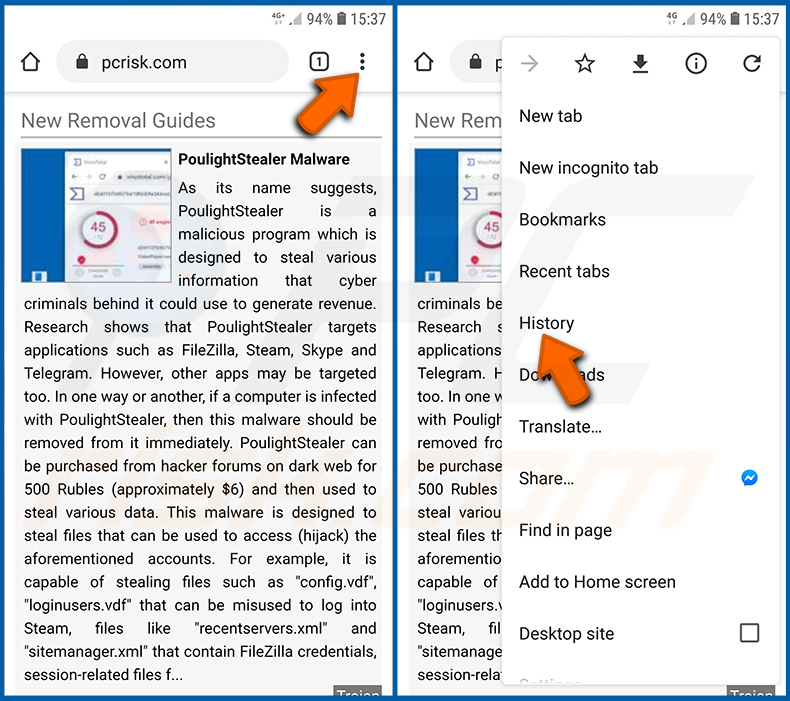
Tap the "Menu" button (three dots on the right-upper corner of the screen) and select "History" in the opened dropdown menu.
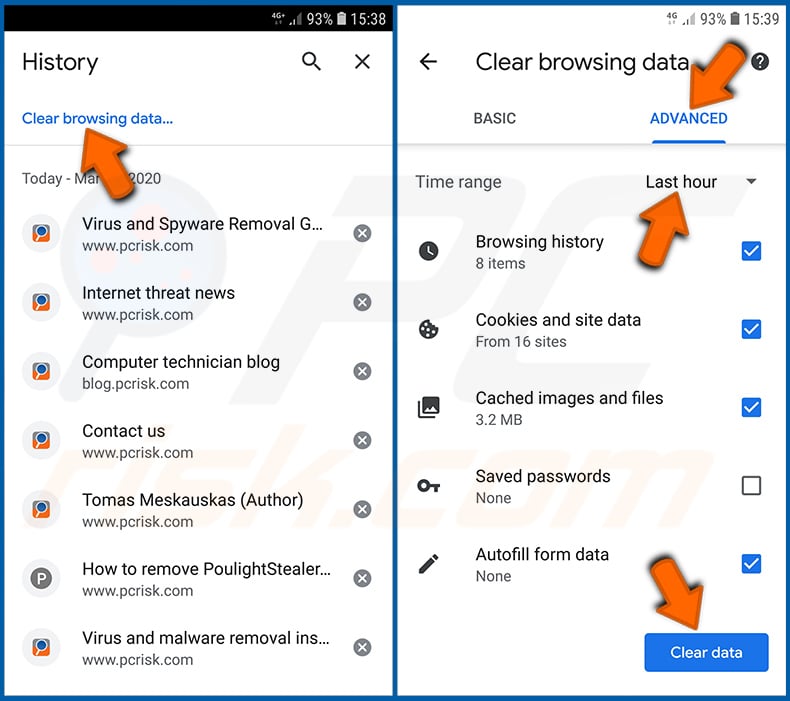
Tap "Clear browsing data", select "ADVANCED" tab, choose the time range and data types you want to delete and tap "Clear data".
Disable browser notifications in the Chrome web browser:
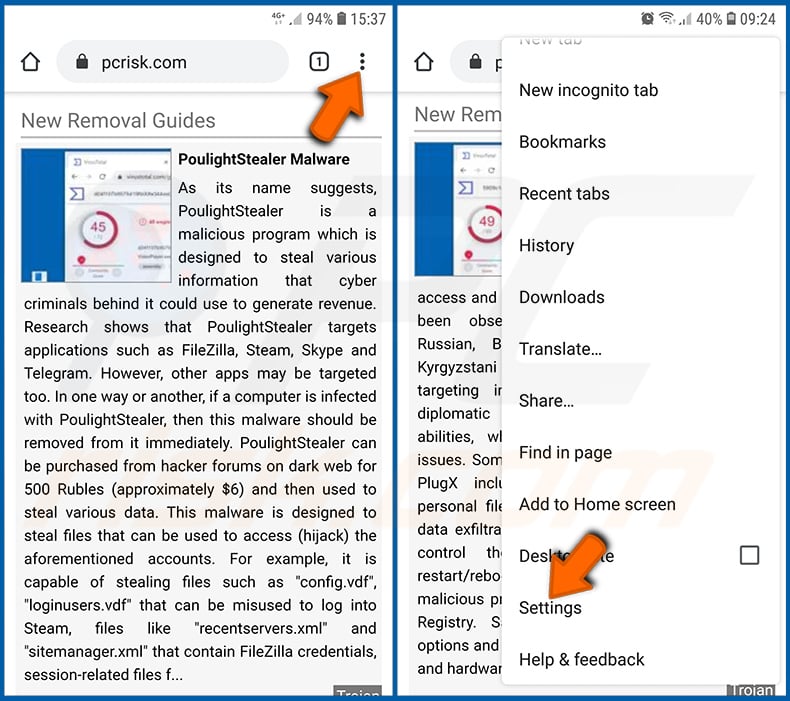
Tap the "Menu" button (three dots on the right-upper corner of the screen) and select "Settings" in the opened dropdown menu.
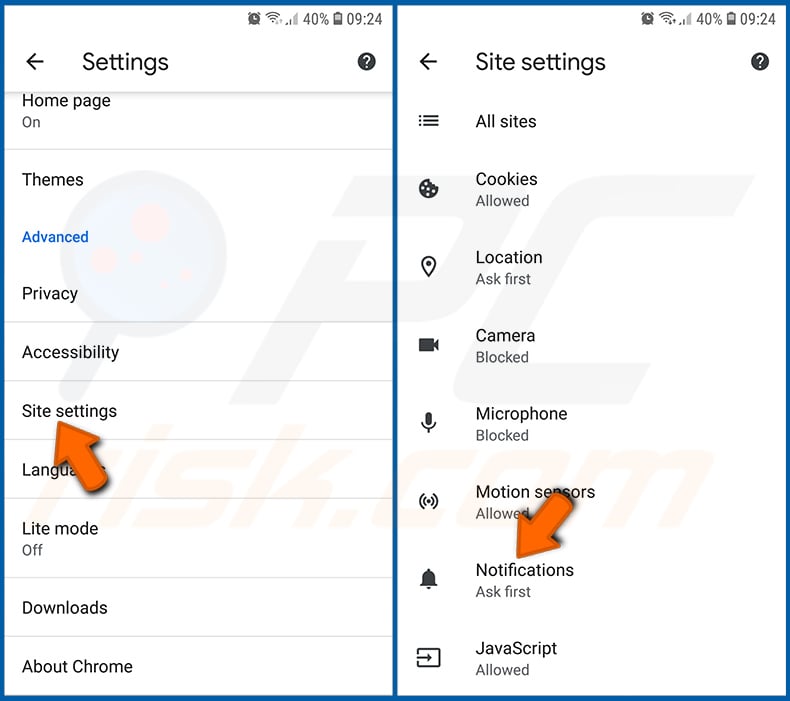
Scroll down until you see "Site settings" option and tap it. Scroll down until you see "Notifications" option and tap it.
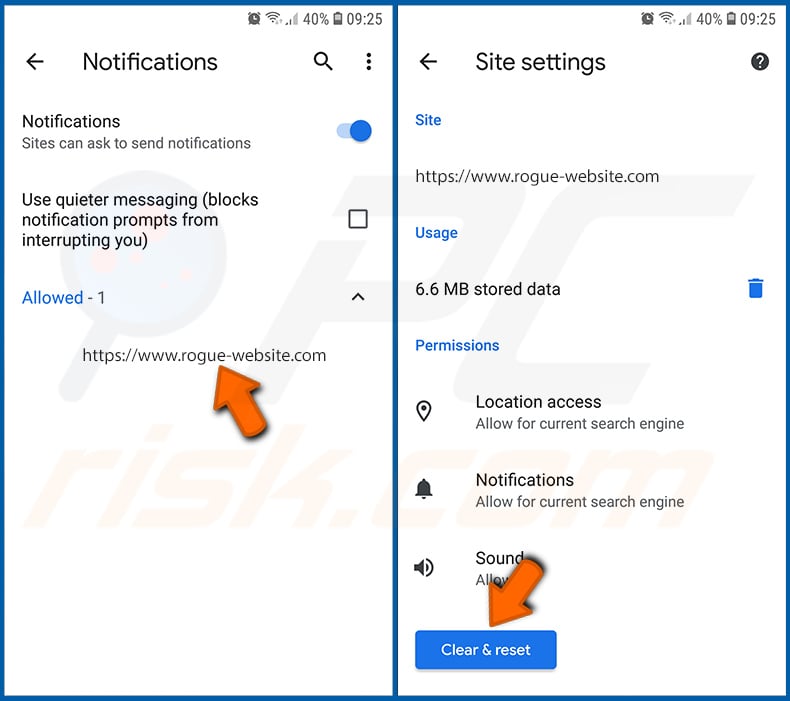
Find the websites that deliver browser notifications, tap on them and click "Clear & reset". This will remove permissions granted for these websites to deliver notifications. However, once you visit the same site again, it may ask for a permission again. You can choose whether to give these permissions or not (if you choose to decline the website will go to "Blocked" section and will no longer ask you for the permission).
Reset the Chrome web browser:
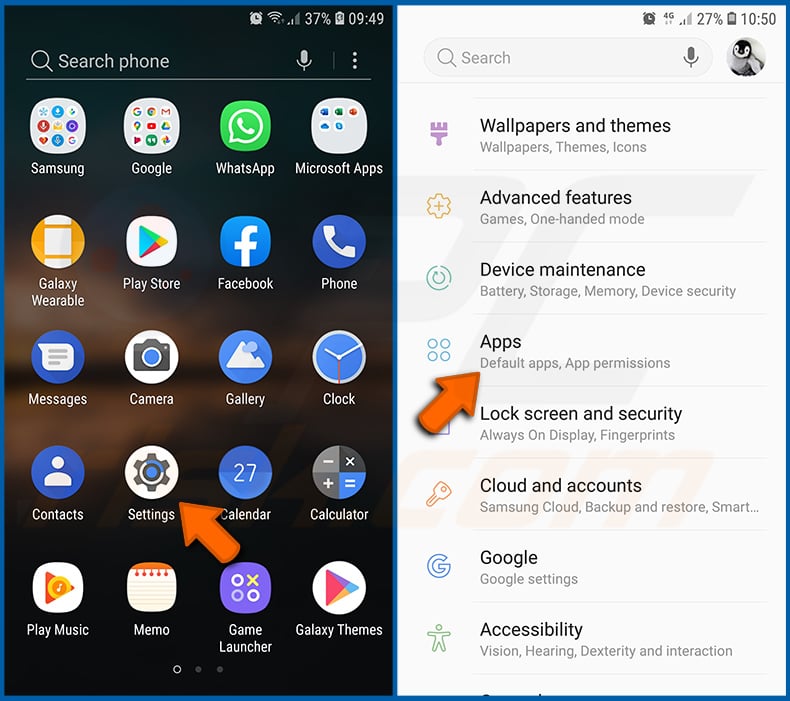
Go to "Settings", scroll down until you see "Apps" and tap it.
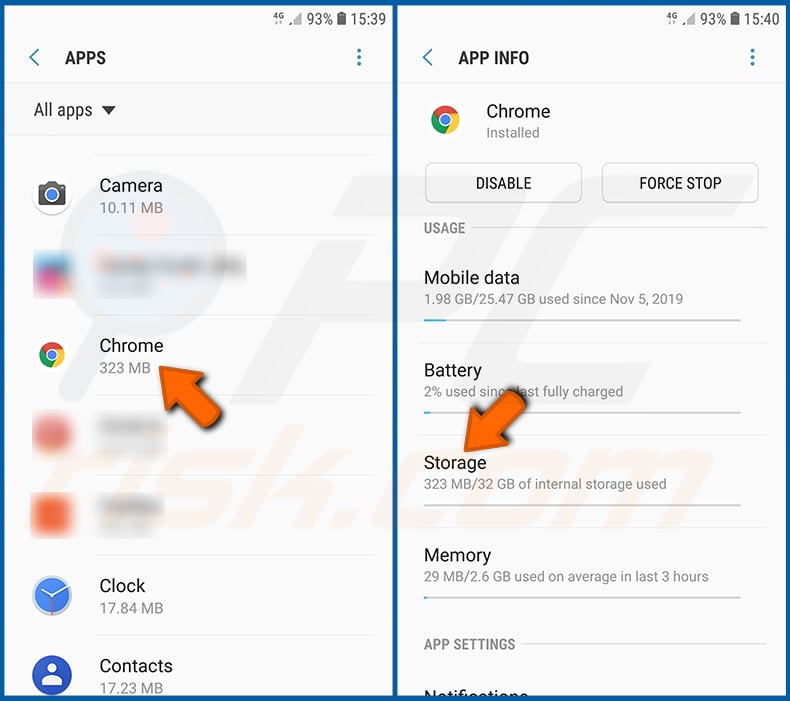
Scroll down until you find "Chrome" application, select it and tap "Storage" option.
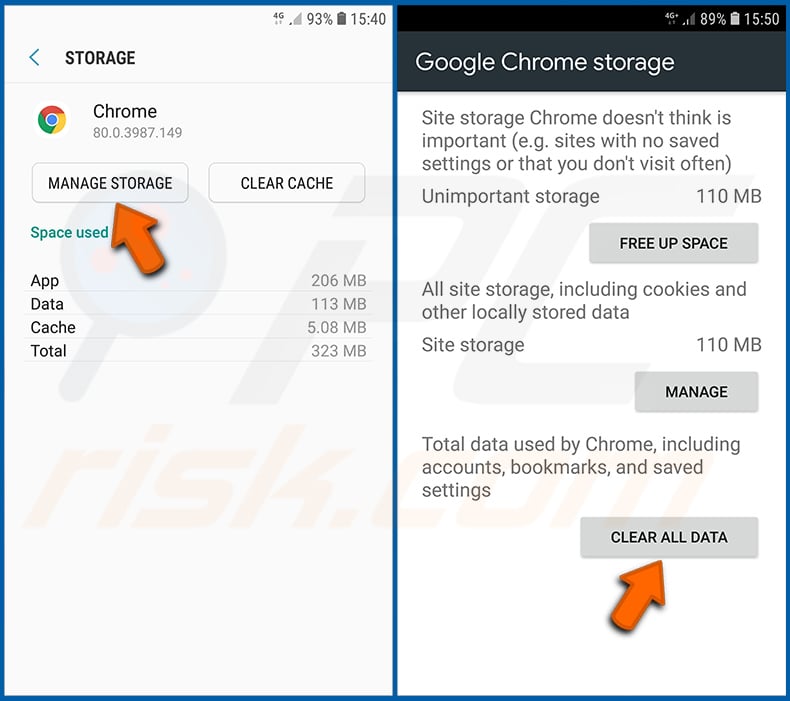
Tap "MANAGE STORAGE", then "CLEAR ALL DATA" and confirm the action by taping "OK". Note that resetting the browser will eliminate all data stored within. This means that all saved logins/passwords, browsing history, non-default settings and other data will be deleted. You will also have to re-login into all websites as well.
Delete browsing history from the Firefox web browser:
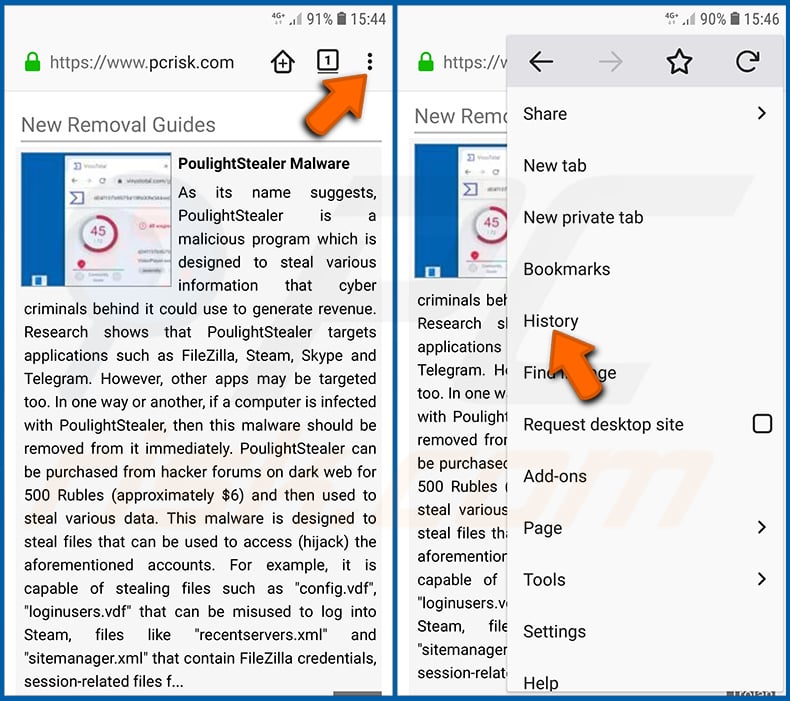
Tap the "Menu" button (three dots on the right-upper corner of the screen) and select "History" in the opened dropdown menu.
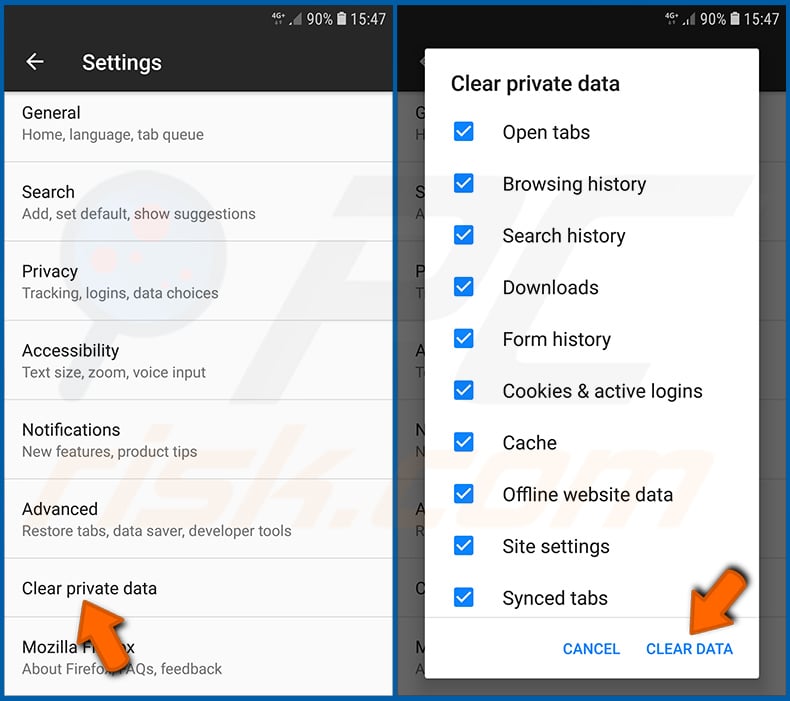
Scroll down until you see "Clear private data" and tap it. Select data types you want to remove and tap "CLEAR DATA".
Disable browser notifications in the Firefox web browser:
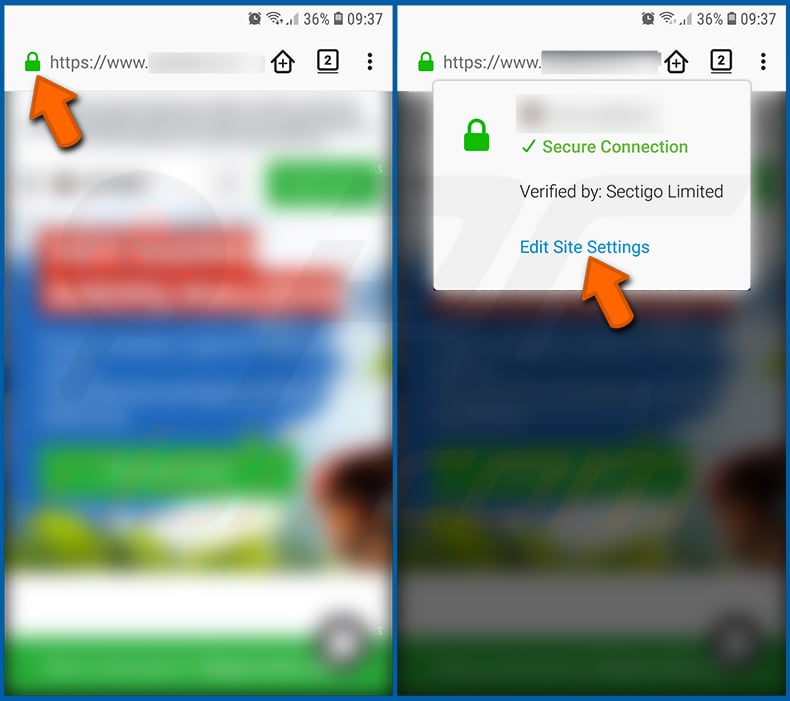
Visit the website that is delivering browser notifications, tap the icon displayed on the left of URL bar (the icon will not necessarily be a "Lock") and select "Edit Site Settings".
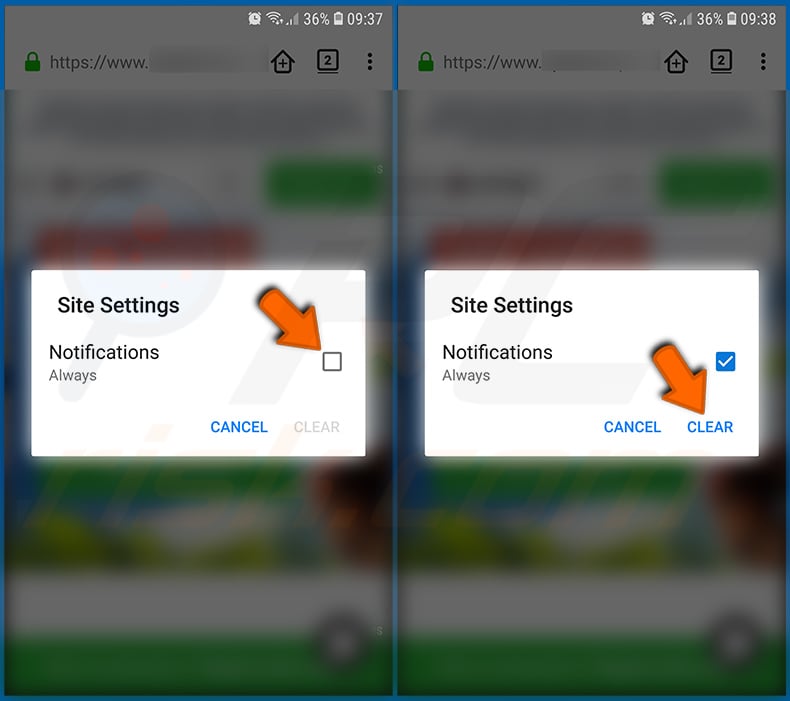
In the opened pop-up opt-in the "Notifications" option and tap "CLEAR".
Reset the Firefox web browser:
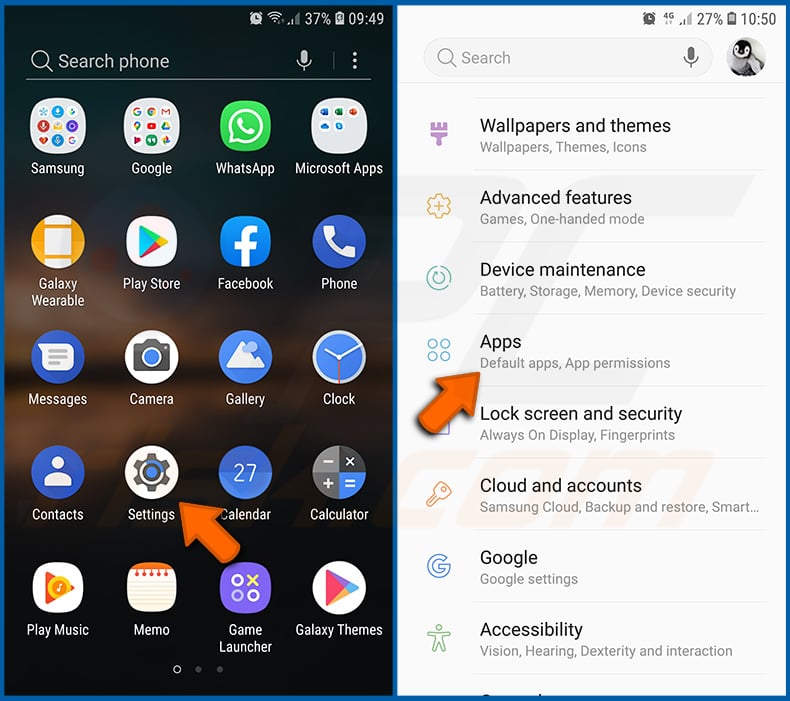
Go to "Settings", scroll down until you see "Apps" and tap it.
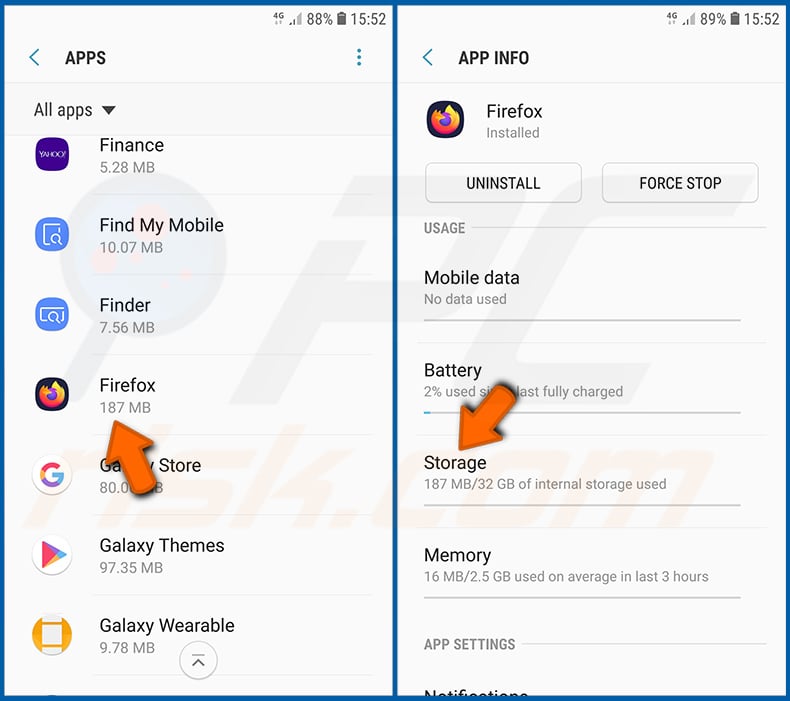
Scroll down until you find "Firefox" application, select it and tap "Storage" option.

Tap "CLEAR DATA" and confirm the action by taping "DELETE". Note that resetting the browser will eliminate all data stored within. This means that all saved logins/passwords, browsing history, non-default settings and other data will be deleted. You will also have to re-login into all websites as well.
Uninstall potentially unwanted and/or malicious applications:
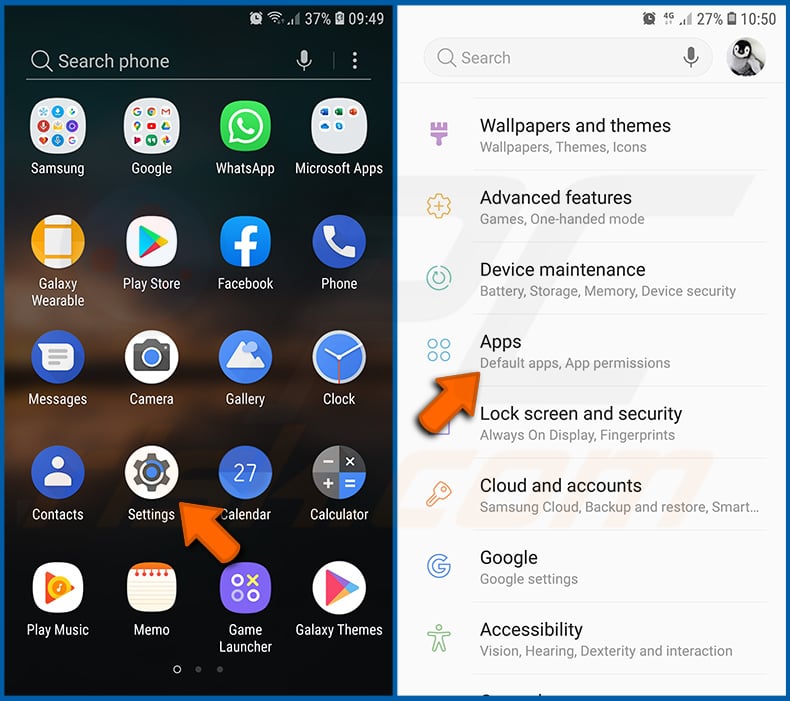
Go to "Settings", scroll down until you see "Apps" and tap it.
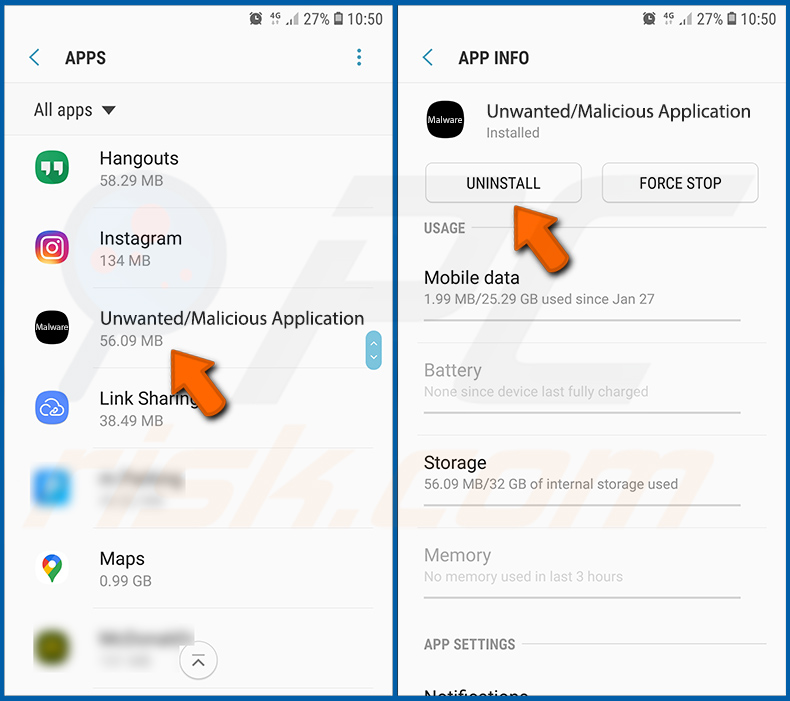
Scroll down until you see a potentially unwanted and/or malicious application, select it and tap "Uninstall". If, for some reason, you are unable to remove the selected app (e.g., you are prompted with an error message), you should try using the "Safe Mode".
Boot the Android device in "Safe Mode":
The "Safe Mode" in Android operating system temporarily disables all third-party applications from running. Using this mode is a good way to diagnose and solve various issues (e.g., remove malicious applications that prevent users you from doing so when the device is running "normally").
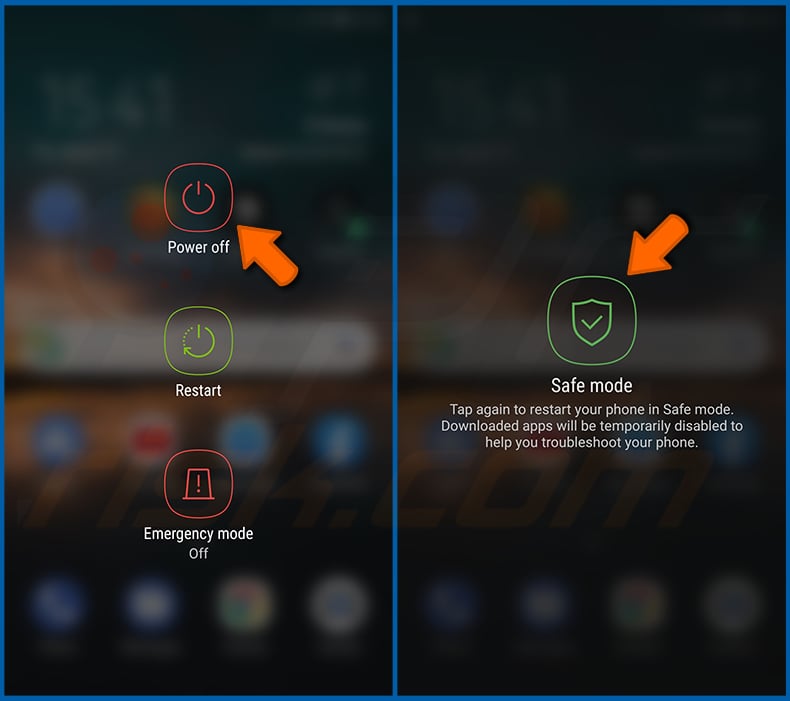
Push the "Power" button and hold it until you see the "Power off" screen. Tap the "Power off" icon and hold it. After a few seconds the "Safe Mode" option will appear and you'll be able run it by restarting the device.
Check the battery usage of various applications:
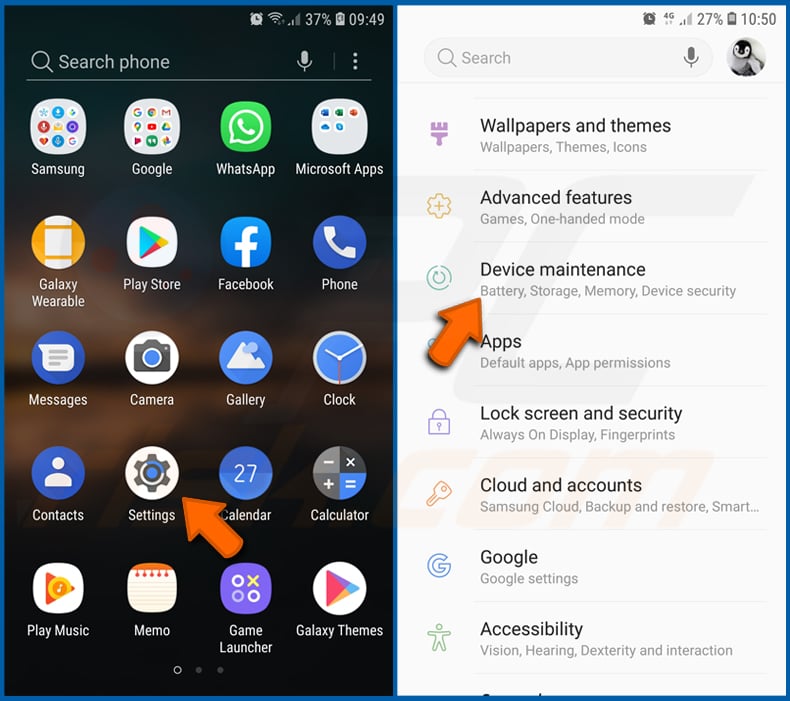
Go to "Settings", scroll down until you see "Device maintenance" and tap it.
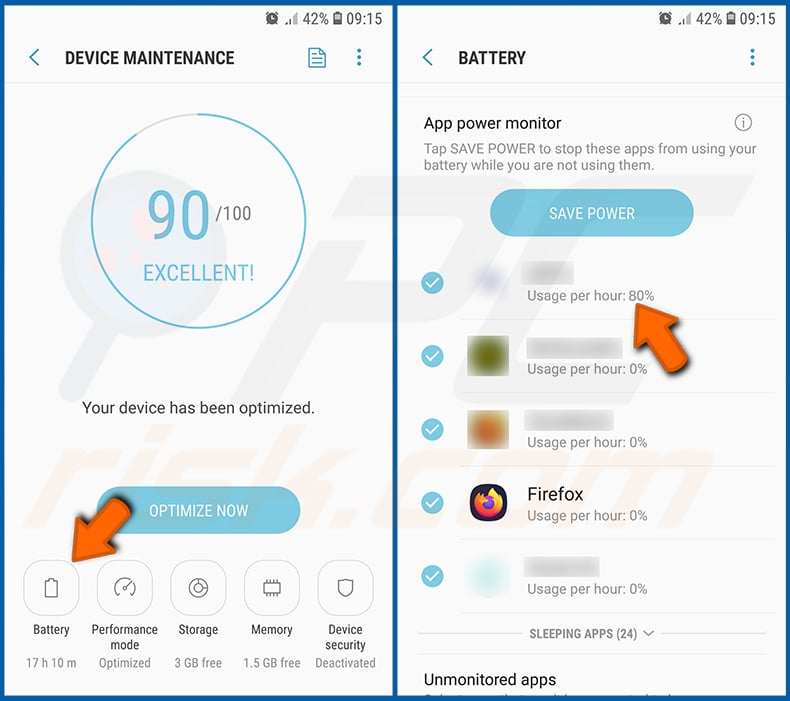
Tap "Battery" and check the usage of each application. Legitimate/genuine applications are designed to use as low energy as possible in order to provide the best user experience and to save power. Therefore, high battery usage may indicate that the application is malicious.
Check the data usage of various applications:
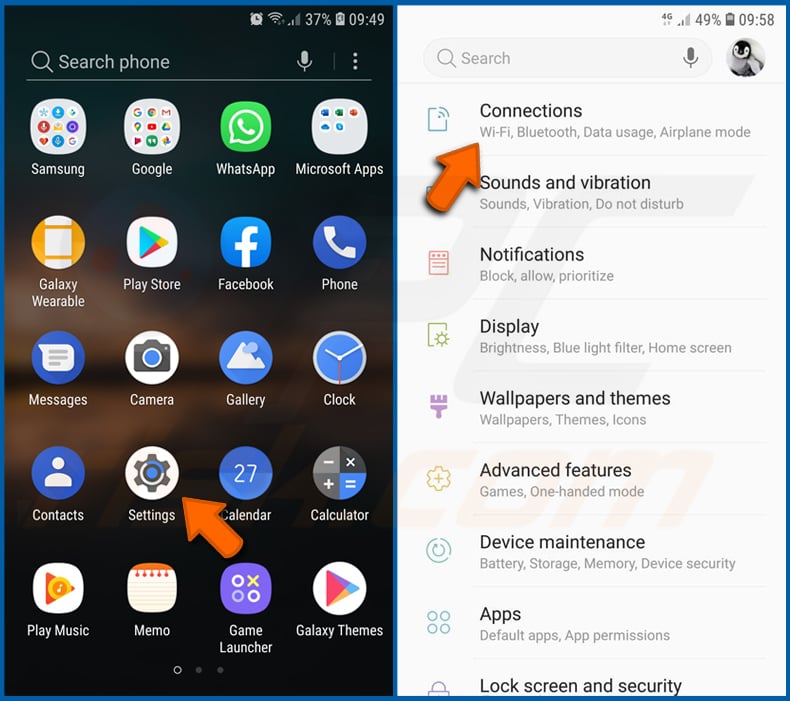
Go to "Settings", scroll down until you see "Connections" and tap it.
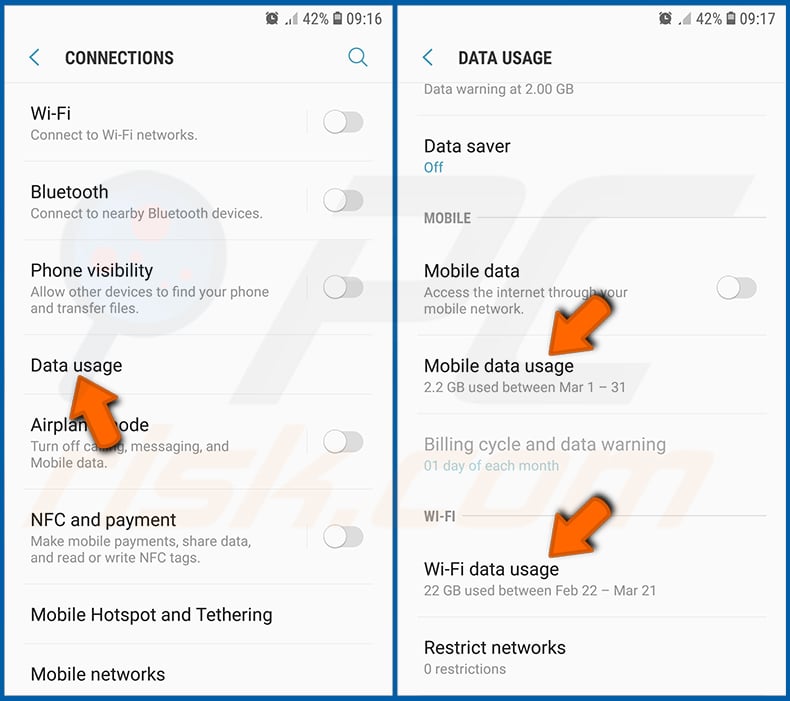
Scroll down until you see "Data usage" and select this option. As with battery, legitimate/genuine applications are designed to minimize data usage as much as possible. This means that huge data usage may indicate presence of malicious application. Note that some malicious applications might be designed to operate when the device is connected to wireless network only. For this reason, you should check both Mobile and Wi-Fi data usage.
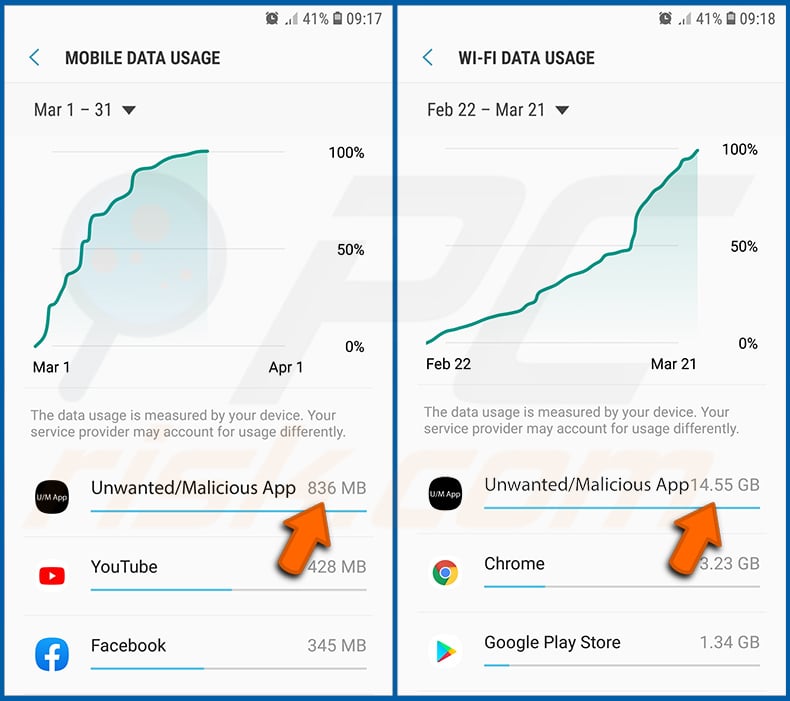
If you find an application that uses a lot of data even though you never use it, then we strongly advise you to uninstall it as soon as possible.
Install the latest software updates:
Keeping the software up-to-date is a good practice when it comes to device safety. The device manufacturers are continually releasing various security patches and Android updates in order to fix errors and bugs that can be abused by cyber criminals. An outdated system is way more vulnerable, which is why you should always be sure that your device's software is up-to-date.
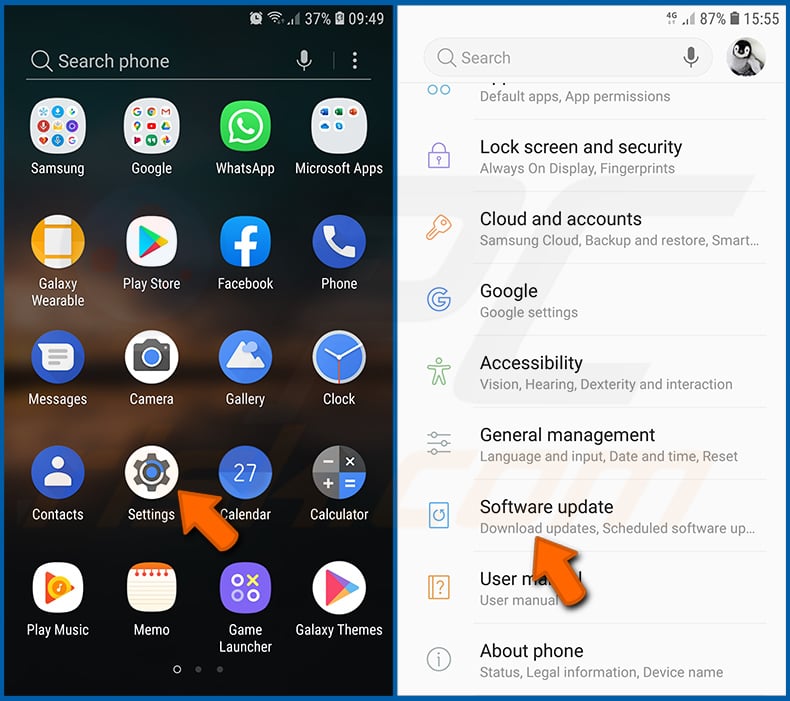
Go to "Settings", scroll down until you see "Software update" and tap it.
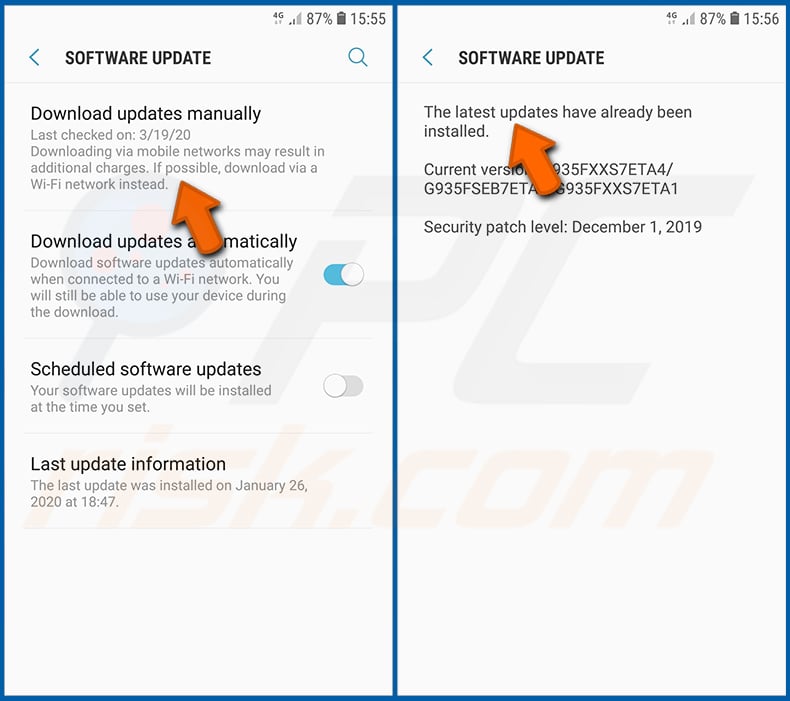
Tap "Download updates manually" and check if there are any updates available. If so, install them immediately. We also recommend to enable the "Download updates automatically" option - it will enable the system to notify you once an update is released and/or install it automatically.
Reset the system to its default state:
Performing a "Factory Reset" is a good way to remove all unwanted applications, restore system's settings to default and clean the device in general. However, you must keep in mind that all data within the device will be deleted, including photos, video/audio files, phone numbers (stored within the device, not the SIM card), SMS messages, and so forth. In other words, the device will be restored to its primal state.
You can also restore the basic system settings and/or simply network settings as well.
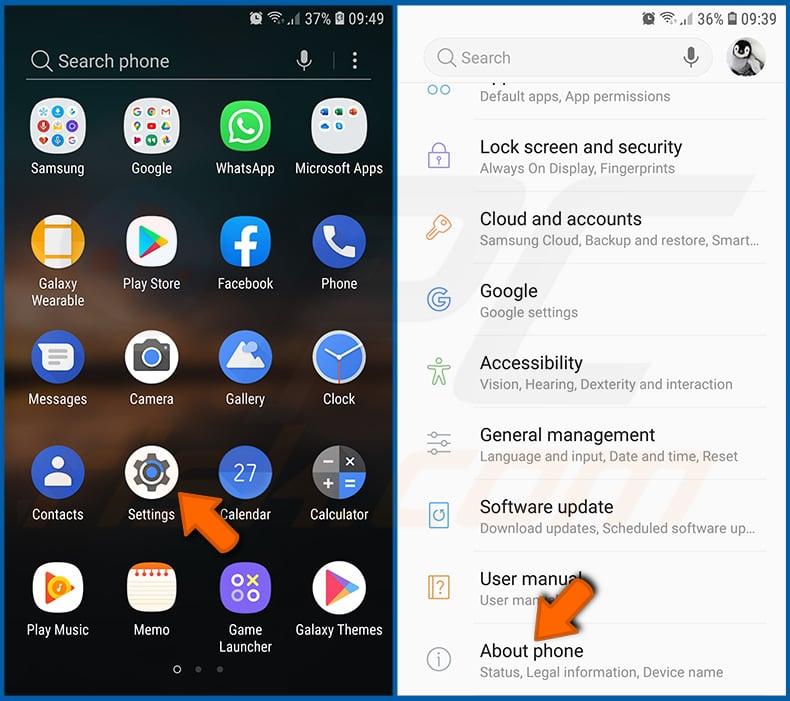
Go to "Settings", scroll down until you see "About phone" and tap it.
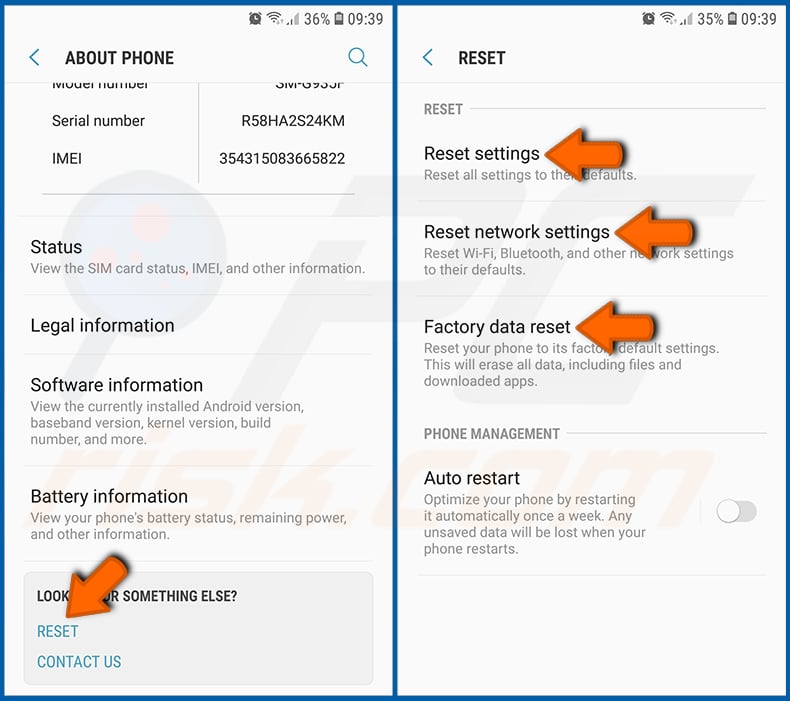
Scroll down until you see "Reset" and tap it. Now choose the action you want to perform:
"Reset settings" - restore all system settings to default;
"Reset network settings" - restore all network-related settings to default;
"Factory data reset" - reset the entire system and completely delete all stored data;
Disable applications that have administrator privileges:
If a malicious application gets administrator-level privileges it can seriously damage the system. To keep the device as safe as possible you should always check what apps have such privileges and disable the ones that shouldn't.
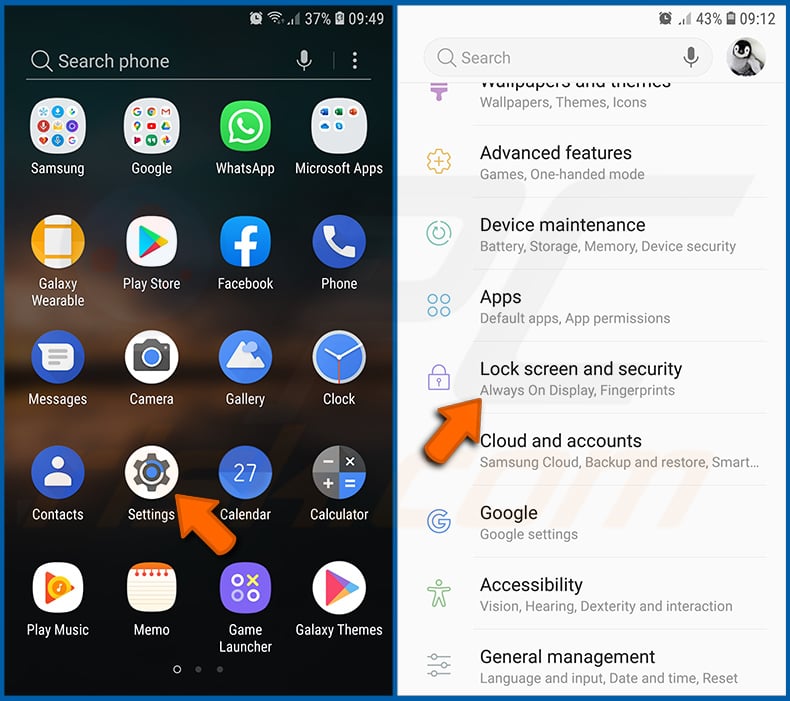
Go to "Settings", scroll down until you see "Lock screen and security" and tap it.
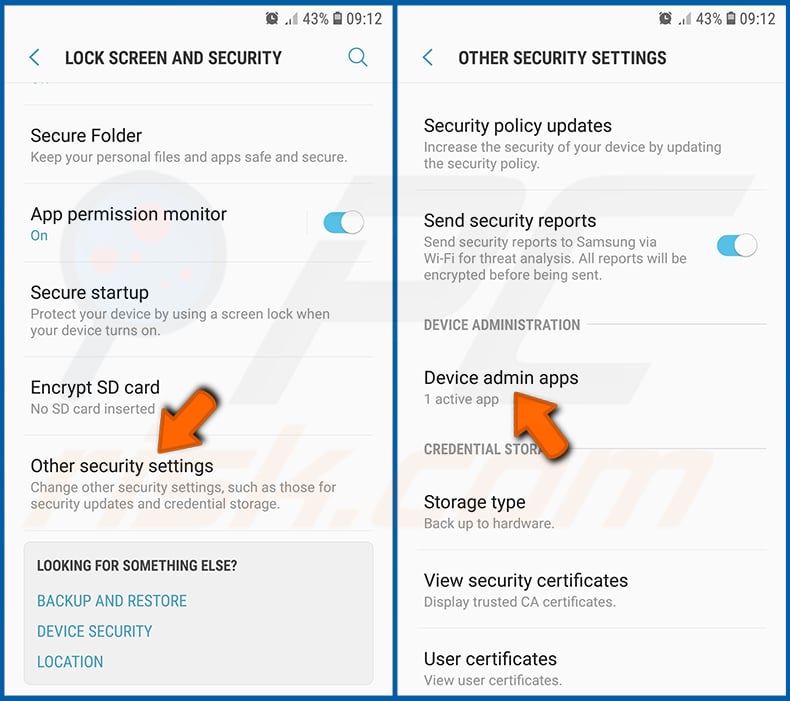
Scroll down until you see "Other security settings", tap it and then tap "Device admin apps".
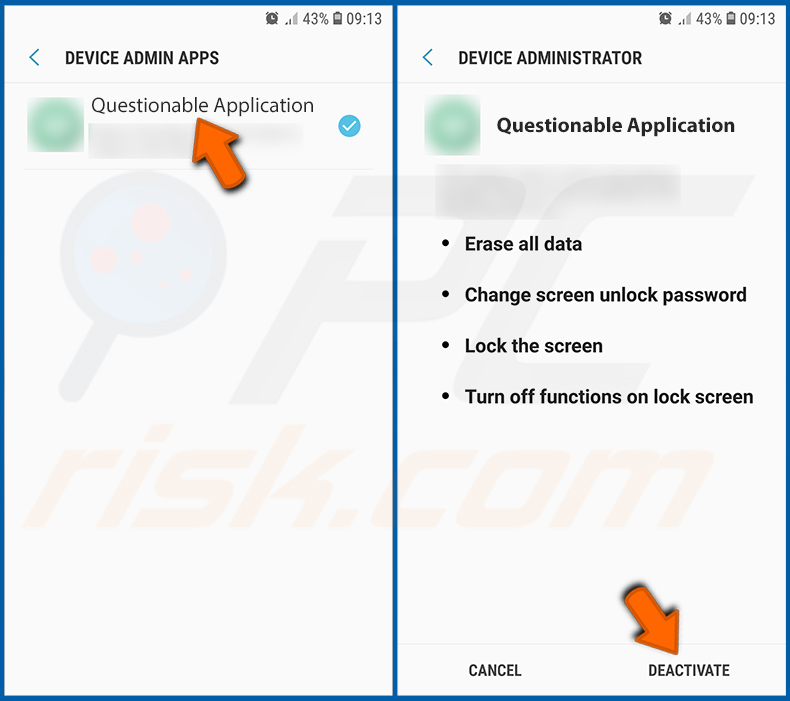
Identify applications that should not have administrator privileges, tap them and then tap "DEACTIVATE".
Frequently Asked Questions (FAQ)
What is a pop-up scam?
Pop-up scams are a type of deceptive content promoted on the Web. These scams aim to trick users into downloading/installing software, purchasing products, subscribing to services, calling fake support lines, allowing scammers to access their devices remotely, making monetary transactions, disclosing sensitive data, and so on.
What is the purpose of a pop-up scam?
The purpose of pop-up scams is to generate revenue at their victims' expense. Scammers primarily profit by endorsing content (e.g., websites, software, products, services, etc.), acquiring funds through deception, abusing/selling private data, and proliferating malware.
Why do I encounter fake pop-ups?
Pop-up scams are predominantly promoted via webpages using rogue advertising networks, intrusive adverts, spam (e.g., emails, PMs/DMs, social media posts, browser notifications, etc.), mistyped URLs, and adware.
Will Combo Cleaner protect me from pop-up scams?
Combo Cleaner can scan visited sites for rogue, scam, and malicious content. It can also block all further access to such webpages
Share:

Tomas Meskauskas
Expert security researcher, professional malware analyst
I am passionate about computer security and technology. I have an experience of over 10 years working in various companies related to computer technical issue solving and Internet security. I have been working as an author and editor for pcrisk.com since 2010. Follow me on Twitter and LinkedIn to stay informed about the latest online security threats.
PCrisk security portal is brought by a company RCS LT.
Joined forces of security researchers help educate computer users about the latest online security threats. More information about the company RCS LT.
Our malware removal guides are free. However, if you want to support us you can send us a donation.
DonatePCrisk security portal is brought by a company RCS LT.
Joined forces of security researchers help educate computer users about the latest online security threats. More information about the company RCS LT.
Our malware removal guides are free. However, if you want to support us you can send us a donation.
Donate
▼ Show Discussion